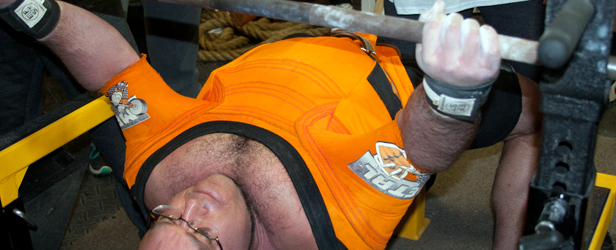
The infamous Paul Key has been training with Team Samson for the past few months. During this time, he has suggested tweaks that have/will lead to significant improvements in the bench press for Adam, Brian, myself, and the other members of the Team Samson gym. Hence, I thought I would take a moment to share some of the basic principles that guide Paul in programming for the bench press.
Paul Key began competing in the bench press in 2000. Since that time his shirted competition bench press has gone from 585 pounds to 840 pounds while his raw bench progressed from 500 pounds to 615 pounds. Louie Simmons invited Paul to come train at Westside after a local meet in 2001. (Paul benched 585 pounds at that meet in the 275-pound weight class). Paul learned many things that year while training under Louie, George Halbert, and Clay Brandenburg, and he still uses many of the movements and training ideas learned during that time. After one year of training at Westside, Paul registered a competition bench of 755 pounds. That’s a 170-pound gain in one year!
When setting up a strength training cycle for a multi-ply bencher, Paul utilizes some tried and true methods that are simple yet incredibly effective. In Paul’s own words: “I learned a lot training at [Westside], but I also trimmed some things that weren't necessarily the best for increasing my equipped bench. I kept exercises that seemed to increase my bench and kicked things out that didn't work. That eventually turned into the programming I use now and am starting to implement in our training cycle now.”
Raw Lockout Work
It is very important to build raw lockout work for the shirted bench. Raw strength will always be important throughout the entire range of motion, but it simply isn’t as important in the lower part of the ROM for a huge shirted bench (when the shirt provides the most support). Paul has found that the best movements to build lockout are board presses and floor presses against bands or chains. The ideal height of the board will vary somewhat depending on the lifter. A three-board is best for most; however, long-armed benchers like Paul should focus on four-boards. It is also good to sometimes utilize a close grip for added emphasis on the triceps.
Shirted Reverse Band Benching
Paul likes using the reverse band setup with shirted benching for a few reasons. Firstly, it allows you to work full ROM without beating you up as much. Paul believes that it is key (no pun intended) to practice touching your chest (i.e. Full ROM) in a shirt frequently during training. Many lifters do not actually touch during the meet and instead may only go to a one/half-board. Paul argues that this just isn’t the same as going all the way, and lifters may tend to panic at the meet once the boards are removed. It is also common for one’s form to be different when touching the chest as compared to when one is touching boards (even lower boards). I have found this to be the case for me in my own personal experience—I have spent entire training cycles becoming very good at touching a one-board only to get to the meet and feel completely helpless when trying to touch my chest. Using reverse bands allows you to touch while still handling heavy weight at the top end. The lightened weight at the bottom will make it harder to touch in a tight shirt, which is better practice.
Reverse band benching can also provide a good indicator of what you are capable of in a meet situation. After one rep in a reverse band setup, it is quite possible to know not only how much you can press at the top, but also how much weight it takes to touch. The trick is to know what your deload is at your chest. Setting up the bands under a monolift makes this much easier to do. You can raise or lower the monolift to increase or decrease your deload. Paul has found that a 100-pound deload seems to work best, but the good thing about using a monolift is that you can easily change the deload each time.
Assistance Day
A second day for accessory movements is something Paul has added into his training recently. The second day is primarily a moderate weight, high volume day. Paul uses bodybuilding-type movements for the muscles of the bench press and focuses on training weaknesses. Occasionally, Paul will add some speed benching to this day when deemed necessary.
Programming
Below is a sample four-week rotation that demonstrates how Paul would set up a routine to train shirted bench:
WEEK 1
First Movement: 4-board raw against Monster Mini Bands. Work to a heavy triple
Second Movement: 2-board shirted against Monster Mini Bands. Work to heavy triple
WEEK 2
First Movement: 3-board shirted triples
Second Movement: Accessory rep work (Sets of 5-8)
WEEK 3
First Movement: Reverse band bench, warmup raw to a medium single and then add shirt
Second Movement: Raw reverse band 3-board, close grip, 3-4 triples
WEEK 4
First Movement: Deload, raw floor press, 3-5×5
Second Movement: Accessory rep work (sets of 8-12)
Use the above rotation for two 4-week cycles and you have an eight-week training cycle for a bench meet. As far as weight selection, this is highly individual and is not tied to certain percentages. The weights used should not be maximal weights but should be heavy. If using this for an eight-week cycle, work to weights that are hard while still leaving some in the tank. Then, aim to beat them during the second four-week rotation. The one day to train 95-100 % would be on the reverse band day since this is when you test yourself in order to gauge what you can touch and what you can press at the meet.








